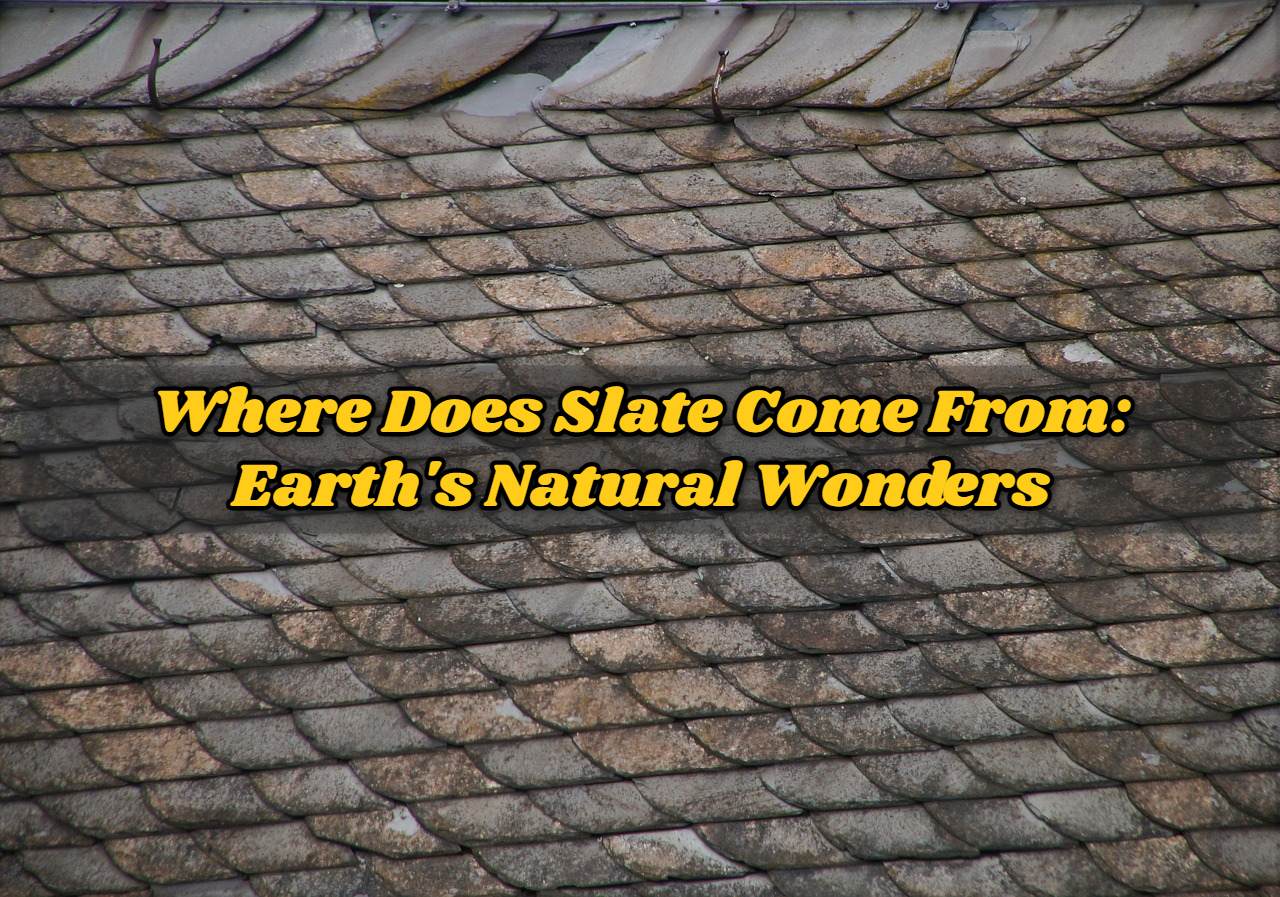Slate is a metamorphic rock that forms from shale under low-grade metamorphic conditions. It originates primarily in regions with historical geological upheaval.
Slate has a long history of forming in geological zones where tectonic activity and sedimentary deposits converge, subjecting shale to high pressure and relatively low temperatures. This transformative process, known as metamorphism, creates the distinctive foliation, or layers, in slate that makes it ideal for various architectural and artistic applications.
The rock typically appears in fine grains and can exhibit a wide range of colors depending on its mineral composition, which adds to its natural appeal. Quarried globally, slate is most commonly associated with roof tiles, flooring, and as a durable, natural writing surface before the advent of pen and paper. Its functionality and aesthetic quality stem from its strength, durability, and cleavage properties, which enable it to be split into thin, smooth sheets.
The Origins Of Slate
Slate is a fine-grained, metamorphic rock derived from sedimentary rock shale. Metamorphism transforms the shale into slate through low-grade regional metamorphism. This natural process involves heat, pressure, and chemical reactions.
Formation Process And Geological Factors
Slate formation is fascinating and intricate. Here’s how it happens:
- Shale, a sedimentary rock, starts the process.
- Heat and pressure then change shale into slate.
- Minerals within the shale, like quartz and muscovite, realign in the process.
- As a result, slate’s hallmark foliation, or layers, emerge.
Geological factors, including tectonic plate movement and heat from the earth’s core, foster conditions necessary for slate to form.
Global Slate Deposits And Their Ages
Different regions across the world house ancient slate deposits. See the global spread below:
| Location | Age | Notable Features |
|---|---|---|
| Wales, UK | Cambrian | Famed for its historic quarries. |
| Pennsylvania, USA | Devonian | Abundant in high-quality slate. |
| Spain | Ordovician | World’s largest producer of natural slate. |
Slate’s age tells a story of Earth’s history. These stones can be over 500 million years old, revealing ancient geological conditions indispensable for slate creation.
Extracting Slate From The Earth
The story of slate begins deep beneath the Earth’s surface. Nature’s mighty forces push and compress mud and volcanic ash over eons. This process forms slate, a durable and beautiful stone used in roofing, flooring, and other applications. But how do we get this natural wonder from the ground to our homes? Let’s dig in.
Quarrying Techniques Through History
In the past, workers used simple tools to extract slate. They split the rock along its natural layers. Picks, chisels, and hammers were their trusty allies. They worked tirelessly to free slabs of stone from the earth. Let’s travel through time to see how they did it:
- Hand splitting: This age-old method uses a hammer and chisel to follow the slate’s natural grain.
- Wedge and feathers: Small wedges called feathers spread the slate, allowing for precise breakage.
Modern Mining Methods
Quarrying has entered the 21st century with advanced tools and techniques. Today’s methods allow for safer, more efficient slate extraction. Take a look at how modern mining differs:
- Diamond wire cutting: A wire embedded with diamonds slices through the rock, reducing waste.
- Explosives: Professionals use them carefully to loosen large slate sections for easy removal.
Mining slate involves a balance of respecting tradition and embracing innovation. The result is the perfect slice of nature’s art, ready for our use.
Slate’s Journey: From Quarry To Consumer
The majestic journey of slate from its natural home in the quarry to the modern consumer’s space is fascinating. This ancient stone undergoes an incredible transformation before it graces our homes as durable, stylish surfaces. Discover the remarkable processes it endures along the way. Embark on an exploration of the life cycle of slate—from extraction to the final product in your hands.
Cutting And Shaping Processes
The first step in transforming raw slate into usable materials is cutting and shaping. Specialists use diamond-tipped saws for precision. Here’s how they turn rough rocks into sleek products:
- Sizes are determined: The required dimensions for slabs or tiles guide the cutting process.
- Cutting the slate: High-grade equipment slices through the stone, ensuring neat edges.
- Shaping for purpose: Whether it’s for roofs, floors, or decorative pieces, the slate gets its unique shape at this stage.
Quality Inspection And Grading
Each piece of slate passes through a strict quality check before reaching the market. Masters of the craft inspect for flaws. The grading system ranks slates based on multiple factors:
| Grade | Characteristics |
|---|---|
| A | Top quality with no defects |
| B | Minor imperfections but good overall |
| C | Visible flaws, suitable for less visible areas |
Approved slate then moves on to packaging. Labeling reflects the grade and destination. This ensures buyers receive the right quality for their specific needs.
Uses Of Slate Across Cultures
The uses of slate across cultures span centuries and continents. This versatile material, born from the earth, has found a place in various aspects of human life. From ancient roofing to modern decor, slate has remained a constant yet quiet testament to human ingenuity. Let’s explore how different cultures have utilized this remarkable stone.
Traditional Building Material
Slate is renowned for its durability and longevity. Cultures across the globe have used it extensively in construction. For example:
- Roofing: Its resistance to weather makes it ideal for roofing.
- Flooring: Slate floors can last for generations.
- Structural Stone: In areas rich with slate quarries, it forms the backbone of many structures.
Contemporary Applications In Art And Design
In modern times, slate continues to inspire creativity. Its slate-gray color and textured surface lend themselves to artistic expression:
| Art | Design |
|---|---|
| Painting Canvas: Artists choose slate for its unique texture. | Home Accents: Slate coasters and serving platters are popular. |
| Sculptures: Its malleability allows exquisite carved pieces. | Furniture: Slate tabletops feature in high-end design. |
Conservation Efforts For Slate Landscapes
Conservation Efforts for Slate Landscapes are growing in importance as the balance between cultural heritage and nature protection becomes a focal concern. Slate, with its storied history in roofing and construction, comes from the Earth itself, extracted from quarries that dot our landscapes. Yet, this extraction has impacts, compelling a movement to safeguard the future of these unique areas.
Environmental Impact Of Slate Quarries
The quest for slate has sculpted vast quarry landscapes, altering ecosystems and the natural flow of water. These changes call for careful management and restoration efforts to ensure the longevity of the surrounding environment.
- Monitoring quarry activities to minimize harm
- Implementing water management systems
- Rehabilitating disused quarries into natural habitats
Preserving Historic And Natural Slate Sites
Preservation initiatives shine a light on the cultural and ecological value of these landscapes. They encourage sustainable tourism and ensure historical structures endure for future generations.
- Designating areas as protected sites
- Supporting local conservation projects
- Fostering educational programs about slate heritage

Credit: www.pbs.org
Frequently Asked Questions On Where Does Slate Come From
Where Is Slate Found Naturally?
Slate forms naturally in regions with clay or volcanic ash that undergo low-grade metamorphism. It’s commonly found in mountain belts worldwide, especially in places like Wales, Spain, China, Brazil, and the eastern United States.
How Does Slate Form In Nature?
Slate forms through the metamorphosis of shale, a sedimentary rock. Heat and pressure alter the clay minerals within the shale, hardening it into slate over geologic time.
Is Slate A Natural Stone?
Yes, slate is a naturally occurring metamorphic rock known for its fine-grained texture and durability, commonly used in flooring and roofing.
What Is Slate Formed From?
Slate is a metamorphic rock that forms from the compression of shale, a type of mudstone or clay.
Conclusion
Understanding slate’s origins enhances our appreciation for this natural marvel. Quarried from ancient sedimentary rock, slate has traveled from deep earth to beautify spaces. Whether for roofing or artistry, this material connects us with Earth’s history. Embrace the slate’s story in your next project.









Leave a Reply